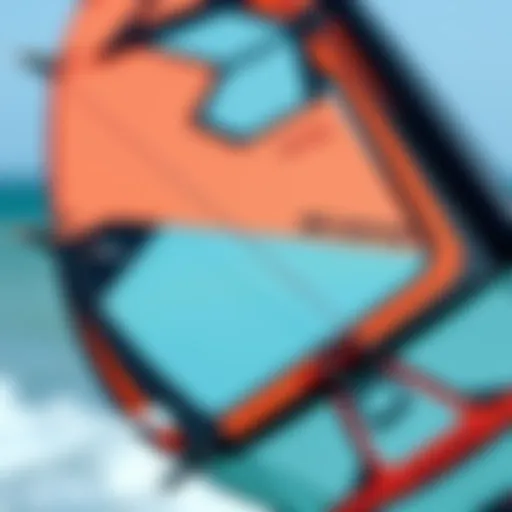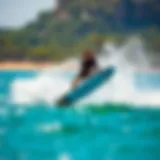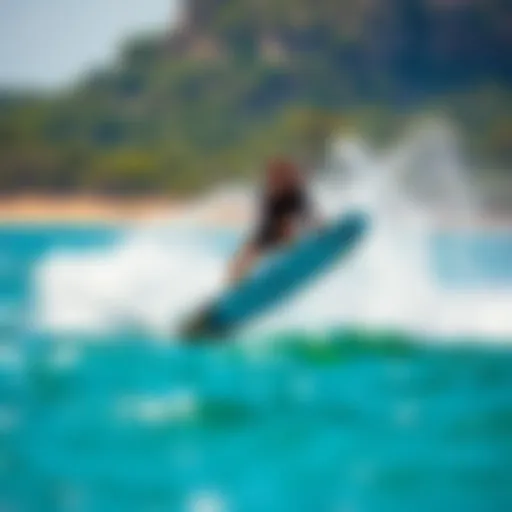In-Depth Reviews of Dry Suits for Kiteboarding


Gear Insights
When it comes down to kiteboarding, one can't understate the significance of proper gear. Dry suits specifically designed for kiteboarding offer solutions that keep enthusiasts warm and dry, especially in unpredictable weather. These suits are essential for anyone looking to brave chilly waters or fierce winds. The aim here is to break down some of the top choices on the market, alongside their unique offerings.
Latest Gear Reviews
- O'Neill Epic Dry Suit
The O'Neill Epic has a sturdy build but doesn’t skimp on flexibility. With its seamless design, it minimizes water entry, while the super stretchy neoprene allows for great movement. Kiteboarders have noted how easy it is to maneuver, whether jumping or performing tricks. - Xcel Drylock Dry Suit
Famous for its remarkable insulation properties, Xcel Drylock features a unique thermal lining to keep one's body heat intact even in frigid waters. Many seasoned riders swear by its durability, ensuring that it withstands the rigors of frequent use. - GUL Response Dry Suit
This suit strikes an excellent balance between cost and features. The GUL Response caters to beginners with a lighter fabric that won’t weigh you down, while the reinforced knees make it a solid pick for those just learning the ropes. Users often note its comfort during extended sessions on the water. - Drycase Pro Endurance Suit
For those who see kiteboarding as a lifelong passion, the Drycase Pro is worth considering. Not only does it offer top-notch waterproofing, but it is also built with a multitude of pockets for storage, a great addition for those long kiteboarding outings.
"Choosing the right dry suit can elevate your kiteboarding experience from just fun to absolutely exhilarating. You don’t want to cut corners on insulation or mobility."
Essential Gear for Beginners
For novice kiteboarders, the journey typically begins with acquiring the fundamental gear:
- Kite and Board: Picking the right size and type depending on local conditions is critical.
- Harness: A well-fitting harness ensures comfort and control.
- Dry Suit: Opting for a suit that allows for movement while keeping you dry is vital.
- Safety Gear: Helmets and flotation vests can be life savers.
Purchasing suitable gear tailored for your skill level helps set the groundwork for your kiteboarding journey, making sure you enjoy every gust of wind.
Transitioning to these essential products can provide not just safety, but comfort and enhanced performance in the water. It’s usually a smart investment that pays dividends in both enjoyment and skill development.
By staying updated on the latest gear and understanding the basics, you set yourself up for success in this thrilling sport. Now that we have dissected gear insights, let’s go deeper into the nuances of technique and safety tips.
Prolusion to Dry Suits in Kiteboarding
Kiteboarding is a thrilling sport that many people enjoy, but it comes with its own unique set of challenges. Weather conditions can shift in the blink of an eye, leaving kiteboarders exposed to cold, wind, and even rain. This is where dry suits come into play, acting as the essential armor for adventurers tackling the elements. Investing in a quality dry suit isn't just a matter of comfort; it’s a fundamental aspect that can greatly influence performance and enjoyment on the water.
Understanding Dry Suits
A dry suit is designed to keep water out, ensuring that the kiteboarder stays dry and warm, irrespective of the conditions. Unlike wetsuits, which allow a thin layer of water to enter and insulate by body heat, dry suits offer a completely sealed environment. They are constructed with advanced materials that repel water while still allowing for some breathability, depending on the model.
These suits are generally equipped with specialized zippers, seals, and closures, which require careful selecting for kiteboarding purposes. Looking into these design elements helps ensure the suit can withstand saltwater without deteriorating, while also providing adequate mobility for dynamic movements on the board.
Importance of Insulation for Kiteboarders
Insulation is a key factor in ensuring that kiteboarders can comfortably enjoy longer sessions even under frigid conditions. Here’s why it matters:
- Core Temperature Protection: Maintaining core temperature is crucial, as a drop can lead to diminished performance, fatigue, and risk of hypothermia. A good dry suit effectively traps warm air while keeping cold water out.
- Layering Options: Depending on the temperature and activity level, kiteboarders can layer under a dry suit. Thankfully, many dry suits are designed to accommodate this, enabling users to adjust levels of insulation – from lightweight thermal garments on milder days to heavier thermal suits in deep winter.
- Flexible Design: Modern dry suits often feature flexibility to allow a full range of movement that kiteboarders require. Having insulation that doesn’t hinder mobility is paramount for executing tricks and maneuvers without feeling restricted.
Understanding these aspects of dry suits underscores their importance for anyone serious about kiteboarding. They aren’t just clothing; they’re essential equipment providing safety and enhancing the overall joy of the sport, regardless of weather conditions.
Key Features of Dry Suits
Understanding the essential features of dry suits can make all the difference for kiteboarders, whether you're just dipping your toes in or you’re seasoned in the waves. Each aspect plays a role in not only comfort but also performance in diverse conditions. It’s like piecing together a complex puzzle; every component—down to the stitching—contributes to the overall picture of effectiveness. Let's break down the core features defining dry suits specifically for kiteboarding.
Material Composition
The material of a dry suit dictates its functionality, durability, and suitability for different weather conditions. Most dry suits are crafted from neoprene or GORE-TEX, each with its own advantages. Neoprene tends to be warmer and offers a snug fit which minimizes water entry by stretching around the body. On the other hand, GORE-TEX provides excellent breathability and wind resistance, making it ideal for varying climates.
A well-chosen fabric can resist wear and tear from both the elements and your kiteboarding activities. For instance, if you're cutting through choppy waters, a robust fabric ensures you won’t be left high and dry by early degradation. Remember, thin material might sound appealing for weight, but durability shouldn't be sidelined. Look for suits that have been tested by other kiteboarders for real-world wear issues.
Sealing Mechanisms
When it comes to dry suits, sealing is crucial. The more effective the seals, the less likely you are to find yourself soggier than a wet sponge after a session. There are several types of seals in dry suits, including wrist seals, neck seals, and zipper seals. Latex seals are popular; they provide a snug fit that minimizes the chance of water sneaking in while still allowing for flexibility.
Additionally, some suits feature Aquaseal zippers or water-resistant zippers, which provide an extra layer of protection. It's essential that these seals have been designed specifically for the rigors of kiteboarding, as you'll be moving a lot. Thus, understanding how the seals operate and how long they last under normal use can save you some serious headaches.
"Invest in the quality of the seams and seals; they are the barriers between you and the unforgiving waters."
Ventilation Systems

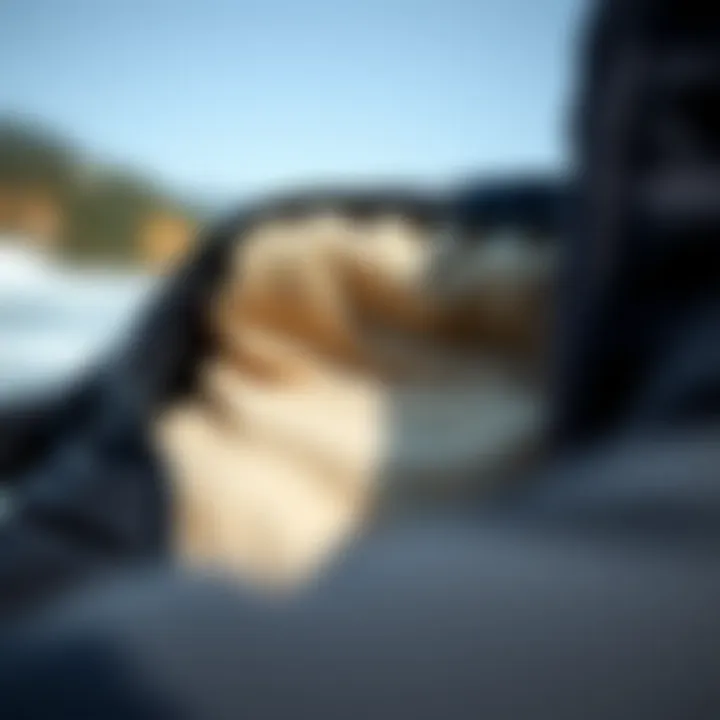
While staying dry is a main goal, it’s equally important to avoid overheating. That's where a solid ventilation system comes into play, allowing for temperature regulation as you paddle, twist, and turn on the board. Many modern dry suits incorporate features like adjustable vents or clever mesh panels to manage airflow effectively.
When scouting for a dry suit, pay attention to how these ventilation features work—are they easily accessible while in motion? Can they be adjusted easily with one hand? The ability to adapt comfort on demand could transform your ride, turning near suffocation into a breathable experience, especially during intense sessions.
Additionally, pick a suit that offers a good balance between insulation and ventilation. If you find yourself sweating through static moments before a gust, the right ventilation keeps your focus on the next wave instead of wrestling with uncomfortably warm temperatures.
Performance Metrics
When it comes to kiteboarding, especially when the winds howl and the waters turn choppy, the performance of your dry suit plays a pivotal role. Performance metrics help quantify aspects that can make or break your experience out on the waves. Each metric focuses on a different characteristic of the dry suit, showcasing how it can enhance safety, comfort, and overall enjoyment. Having a solid grasp of these metrics not only allows enthusiasts to select the right suit but also ensures they can push their limits without worry.
Thermal Protection
In kiteboarding, one of the key challenges is temperature regulation. The sea breeze can chill you to the bone, even on a sunny day. A suit designed with exceptional thermal protection keeps the body warm while preventing excess sweat. Look for materials like neoprene, known for its insulative properties. The thickness of the material, typically measured in millimeters, also indicates warmth; a thicker suit provides better protection against cold water.
- Key Factors:
- Material Thickness: Typically ranges from 3mm to 7mm for colder conditions.
- Seam Construction: Seams should be sealed or taped to avoid cold water seeping in.
- Interior Linings: Fleece or other insulating linings add an extra layer of warmth.
“Thermal protection isn’t just about warmth; it’s also about being able to move freely while staying comfortable.”
Mobility and Flexibility
A bulky dry suit can feel like trying to walk through molasses. For kiteboarders, agility is paramount. Thus, mobility and flexibility are essential metrics to consider. The right suit allows for dynamic movements essential for performing tricks or enduring tough conditions. Look for features such as articulated joints and stretchy neoprene to ensure a good range of motion.
- Key Attributes:
- Design Features: Suits designed with pre-bent knees or elbows enhance mobility.
- Stretch Panels: Look for additional stretch zones to improve flexibility during movement.
You don't want to end up like a turtle on its back; your suit should feel like a second skin, working with you as you glide through the air and water.
Weight Considerations
Weight is another critical performance metric as it impacts padding, buoyancy, and overall agility in water. The heavier the suit, the more it can weigh you down, especially when taking a tumble into the surf. Lightweight materials provide necessary protection without sacrificing movement, a combination that's vital for serious kiteboarders.
- Consider This:
- Balance: A heavier suit might offer better thermal protection but could compromise mobility.
- Packability: If you’re traveling, a lighter suit makes for easier transport.
Finding the right balance between weight and performance ultimately enhances your time on the water. Understanding these performance metrics helps kiteboarders make educated decisions, ensuring they stay safe, warm, and ready to ride.
Comparative Reviews of Popular Models
When considering a dry suit for kiteboarding, it’s crucial to know how various models stack up against one another. Comparative reviews not only help potential buyers understand the nuances between different suits, but they also outline the strengths and weaknesses of each option available in the market. These reviews can inform decisions based on personal preferences, riding styles, and environmental conditions that kiteboarders often encounter. Evaluating models side by side allows a clear picture to emerge, enabling you to make a choice that enhances your on-water experience, especially when Mother Nature throws her worst at you.
Model A: Performance Overview
Model A, specifically the NRS Extreme, has gained traction among kiteboarders looking for durability without sacrificing movement. This suit boasts a robust outer layer made of 4-layer nylon, promising to withstand abrasions typical in rugged conditions. Riders often highlight its waterproof zippers which prevent leaks, ensuring that the wearer stays dry during their session.
Notably, this model comes equipped with reinforced knees, which is particularly appreciated by those spending hours navigating in challenging water. And though the suit may have a bulkier initial feel, users point out the surprising range of motion it provides once on the water. The thermal properties make it suitable for cooler conditions, allowing kiteboarders to push their limits without getting cold feet—or cold everything else, for that matter.
Model B: Features and Feedback
Next up is the O'Neill Psycho Tech, a fan favorite. This suit offers a unique blend of features that cater to both performance and comfort. Interestingly, the suit utilizes a unique fluid seam weld technology, providing superior insulation. This means less water penetration while also keeping the suit lightweight. Many users have voiced their appreciation for its ease of getting in and out, often a headache with dry suits. The Psycho Tech also has adjustable cuffs to ensure a snug fit, which is essential in preventing water from sneaking in.
Feedback from enthusiasts often credit the suit's design for making it easier to change posture and execute maneuvers. However, it’s worth noting that some reviews have pointed out the suit’s high price point, making it essential for potential buyers to carefully weigh cost against the features offered.
Model C: User Experiences
Lastly, let’s discuss the Mystic Marshall, which has garnered positive attention in recent user reviews. Riders appreciate its versatility and all-season design, making it a solid investment for those who kite throughout the year. Users frequently commend its comfort level, noting that it allows them to kite longer without feeling restricted. The suit incorporates air ventilated panels, which many find to be a breath of fresh air—quite literally—during warm afternoons.
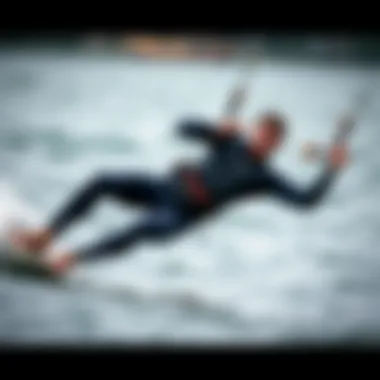
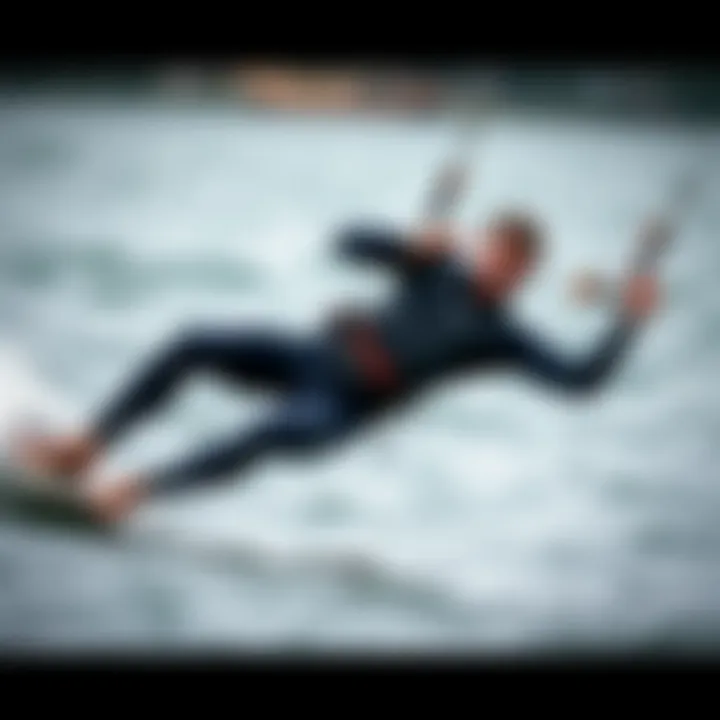
"The Mystic Marshall allowed me to keep going without feeling stifled, even when the sun was blazing. It's versatile for different conditions," says Alex, a dedicated kiteboarder.
However, some have reported minor wear after several seasons, indicating that while the suit performs well initially, it might not have the longevity some expect. Still, the consensus is that the Marshall strikes a fine balance between function and fashion.
By engaging with these comparative reviews, prospective buyers can develop a well-rounded understanding of each model. This not only amplifies their kiteboarding experience but also helps in choosing a suit that matches both style and practicality.
User-Centric Insights
When it comes to selecting a dry suit for kiteboarding, the voices of the users themselves provide a wealth of knowledge that no technical specification sheet can rival. Analyzing user-centric insights serves not only to highlight the real-world application of these suits but also to identify the nuances and quirks that might only become evident through experience. For kiteboarders, both new and seasoned, understanding these insights is crucial for making a worthwhile investment.
This section delves into two key areas: testimonials from beginners, who offer fresh perspectives on their first-time experiences, and expert opinions that carry the weight of extensive field experience. The blend of these insights forms a mosaic of knowledge that can guide potential buyers toward a wise choice.
Testimonials from Beginners
Beginners often bring an honest and unfiltered view when it comes to their first encounters with dry suits. They typically don't have the biases or preconceived notions that seasoned kiteboarders might carry. Take, for instance, Jason, a novice kiteboarder who decided to invest in a dry suit just before his first winter season. He remarked, "I was unsure about spending a chunk of change on something I’d never used before. However, when I first hit the water during that cold afternoon, I knew I had made the right choice. I stayed dry and warm, which was crucial. I could focus on my technique rather than shivering."
Here are a few key takeaways from beginners' testimonials:
- Comfort Matters: New users often report that comfort can make or break their kiteboarding experience. Many mention that finding the right fit is nearly as important as the brand itself.
- User-Friendliness: A number of novices appreciate suits that are easy to put on and take off, which significantly enhances their ability to gear up swiftly and enjoy the water.
- Initial Hesitations: Many express initial doubts about performance at high speeds or during extensive movements, but often find their dry suits exceeding expectations.
Experts Weigh In
In contrast to beginners, expert kiteboarders have been around the block a few times. Their insights are shaped by years spent navigating diverse climates and conditions. Sarah, a professional kiteboarding instructor, had this to say: "You learn to trust your gear. A dry suit isn’t just about staying dry; it affects your range of motion and overall performance on the water."
Experts tend to focus on specific metrics and performance aspects:
- Material Quality: Experts emphasize the importance of breathable fabrics and how they affect comfort during extended sessions.
- Durability: Constant use brings wear and tear, leading experts to evaluate how well different models withstand repeated exposure to saltwater and harsh conditions.
- Functionality in Action: Experienced kiteboarders underline the significance of features like reinforced seams and adjustable neck seals, as these can dramatically influence performance and comfort during rigorous activity.
"What you want in a dry suit is reliability. If it fails you in extreme conditions, it’s more than just an inconvenience; it could be dangerous." - Alex, Professional Kiteboarder
Considerations for Purchase
When it comes to selecting a dry suit for kiteboarding, taking personal circumstances into account is fundamental. Your needs may differ based on various factors including location, climate, and how often you plan to hit the water. Therefore, making an informed decision involves a careful evaluation of specific characteristics like budget, intended use, and where to shop.
Budget vs. Performance
In the kiteboarding world, it's quite common to see people torn between what's affordable and what’s high-quality. Understandably, budget constraints can put a damper on aspirations. However, it is important to remember that a dry suit is an investment.
- Performance Needs: Reflect on performance expectations. A suit designed for lighter winds might not work well in harsher conditions. So, if you live near choppy waters, it could merit spending a bit more on something durable and well-insulated.
- Long-Term Value: While cheaper options might look enticing at first, they often come with sacrifices. So, if a suit lasts just one season, you might end up spending more than if you had opted for a pricier option initially that could last several years.
- Features Worth Investing In: Things like water-resistant zippers, reinforced seams, and thermal lining can greatly affect performance, especially in cold weather.
In essence, balance between budget and desired performance is key. Spending a bit more for longevity and comfort makes sense, especially when you consider your own safety and enjoyment.
Where to Buy: Online vs. Local Stores
When hunting for that perfect dry suit, you’ll likely bump into the age-old dilemma: shop online or visit a brick-and-mortar store? Each option has its own set of advantages.
Online Shopping:
- Wider Selection: The internet can be a veritable treasure trove of options. Websites like REI or Amazon often provide extensive listings, allowing you to compare features easily.
- Customer Reviews: Online platforms let potential buyers gauge the viability of a suit through user experiences. Check reviews, but don’t forget to scrutinize the context of each feedback.
- Convenience: You can browse and order whenever you want without needing to leave your couch.
Local Stores:
- Try Before You Buy: There’s something to be said for the tactile experience of trying on a suit. Each manufacturer has its own fit; what would be a tight size online might actually be loose in reality.
- Expert Guidance: Local shops often come with knowledgeable staff who can offer valuable insights and answer your immediate questions about fit or features.
- Immediate Satisfaction: No waiting for shipping means you can hop on the waves right after you make your purchase.
In sum, weigh the pros and cons of each option. Whether hunting for bargains online or seeking tailored advice from local retailers, being informed is imperative. Make your decision based on what aligns best with your individual needs and circumstances.
Maintenance of Dry Suits
When it comes to kiteboarding, having a reliable dry suit is essential—especially in less-than-ideal weather. However, it's not just the initial investment in a quality suit that counts; the way you maintain that investment can make all the difference in longevity and performance. Proper maintenance routines not only safeguard the integrity of the suit but also ensure optimal functionality in every adventure out in the water.
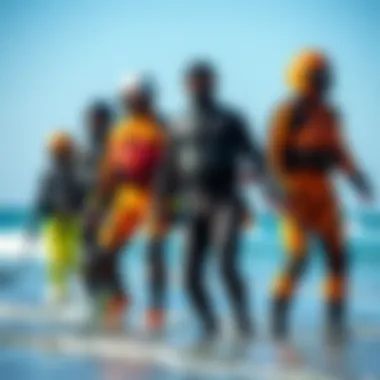
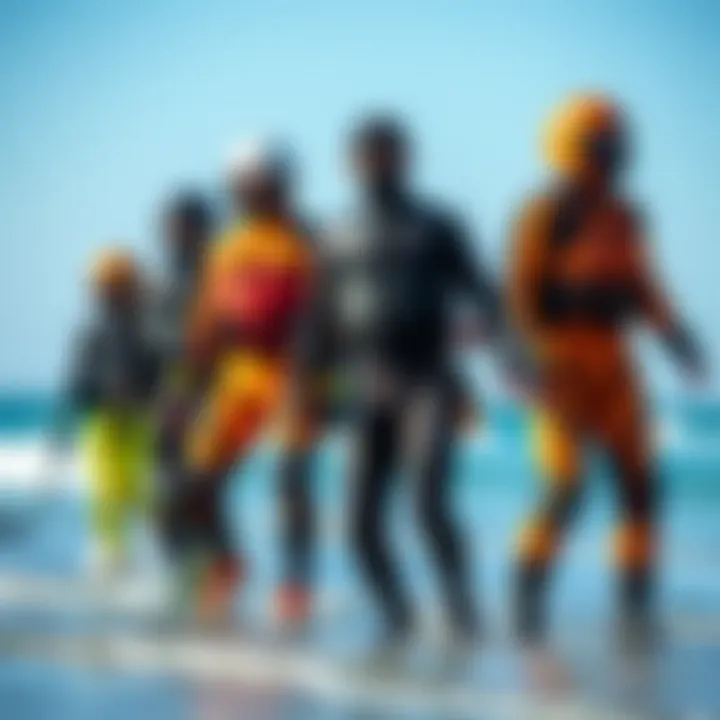
Regular upkeep ensures that your dry suit remains flexible and watertight. It takes only a few moments of care after each use to protect against the harsh elements your suit often encounters. Saltwater, sand, mud, and even sun exposure can wear down its usefulness if left neglected. Thus, understanding and implementing maintenance techniques is a must for every kiteboarder.
Cleaning Techniques
Cleaning your dry suit might sound straightforward, but it’s pivotal to do it correctly to enhance its longevity. Here’s how to go about it:
- Rinse Thoroughly After Use: After every kiteboarding session, it’s crucial to rinse your dry suit with fresh water, especially if you're riding in saltwater or muddy conditions. This quick step helps to remove any corrosive salts or debris that can age the material prematurely.
- Gentle Hand-Washing: For more detailed cleaning, fill a bathtub or a large basin with lukewarm water and add a mild detergent meant for technical fabrics. Avoid fabric softeners, as they can affect the suit's waterproof properties. Submerge your suit and gently scrub areas that see more wear, like the cuffs and knees, using a soft sponge.
- Avoid Machine Washing: A washing machine can be a bit too rough for your dry suit. The agitator can cause unnecessary wear and tear. Stick to hand-washing whenever possible.
- Drying: Once washed, hang the suit upside down in a shaded area, avoiding direct sunlight, which can degrade materials over time. Make sure all zippers and seals are fully closed to maintain their shape and integrity.
- Regular Inspections: Each time you clean your suit is an excellent opportunity to look for any small punctures or worn areas. Catching these early can save you from a subpar performance on the water.
"Proper maintenance ensures that whether it’s a sunny day or a blustery gale, your suit performs seamlessly, keeping you dry and comfortable."
Storage Considerations
Storing your dry suit properly is just as critical as cleaning it. Here are several key points to consider:
- Storage Location: Keep your suit in a cool, dry place when not in use. Avoid attics or basements which can fluctuate greatly in temperature and humidity, potentially damaging the material over time.
- Hanging vs. Folding: Ideally, hang your dry suit on a wide hanger to maintain its shape. Folding it can create creases in critical areas, leading to potential leaks.
- Keep Away from Light: Exposure to sunlight can weaken the materials. If possible, keep your suit in a dark, cool closet or storage bag.
- Regular Check-In: Even in storage, it's smart to check your dry suit periodically. Look out for any signs of deterioration or pest damage, and don't hesitate to give it a rinse if it’s been a while since your last use.
By adhering to these maintenance tips for your dry suit, you can ensure that you're not just investing wisely, but also maximizing the performance of that investment in every kiteboarding session. Whether you're racing waves or just cruising along, you can enjoy the ride without the worry of letting a little wear and tear hinder your fun.
The End
In exploring the significance of dry suits for kiteboarding, it becomes clear that the right choice can vastly impact one's experience out on the water. Kiteboarding enthusiasts navigate through various conditions, from sunny shores to gusty winds and frigid waters. Thus, having an appropriate dry suit is not merely a convenience, but a necessity that enhances both safety and enjoyment.
Summary of Key Points
A comprehensive look into dry suits reveals several core aspects critical for kiteboarders:
- Material Technology: High-quality fabrics such as Gore-Tex and neoprene provide optimal waterproofing and breathability, important for avoiding moisture buildup.
- Sealing Mechanisms: Look for suits with robust seals at wrists and ankles to keep water out while allowing for flexibility.
- User Preferences: Feedback from actual users, ranging from novices to experienced kiteboarders, provides invaluable insights, helping you make an informed decision.
These highlights illustrate not only the practical benefits of investing in a dry suit but also the nuances that come with each model and brand.
Final Thoughts on Selecting the Right Dry Suit
Choosing the right dry suit involves careful consideration of various factors such as fit, features, and environmental conditions. Here are a few tips to keep in mind:
- Fit Matters: Ensure the suit fits snug but not too tight; this aids in mobility while maintaining insulation.
- Functionality Over Fashion: While aesthetics have their place, prioritize features like pocket placements, zipper quality, and venting options.
- Test Different Brands: Every brand has its unique sizing and technology; trying them on can make a big difference in comfort and performance.
Remember, your dry suit is an investment not just in gear but in creating memorable kiteboarding moments. Take your time, do your homework, and choose wisely. Enhance your kiteboarding experience by staying warm, dry, and ready for adventure, no matter the conditions.
Further Reading and Resources
The quest for proficiency in kiteboarding does not end with just purchasing the right gear. It’s essential to stay informed and engaged with the community around this exhilarating sport. In this section, we’ll delve into how further reading and resources can enhance your kiteboarding experience, providing you with valuable knowledge and insights that can ultimately influence your performance on the water.
One major aspect of kiteboarding is understanding the gear itself, particularly dry suits. Whether you’re a novice looking to make your first equipment choice or a seasoned kiteboarder refining your setup, the right resources can bridge gaps in knowledge and help you stay ahead of the game. Here are the key benefits:
- Up-to-Date Information: The world of kiteboarding is ever-evolving. New technologies and gear designs emerge constantly. Staying informed through articles and online resources ensures you’re not left behind.
- Community Insights: Engaging with fellow kiteboarders through forums or social media platforms allows you to access a wealth of firsthand experiences. Understanding how others interact with their gear helps you make more informed decisions.
- Safety Protocols: Kiteboarding entails certain risks, especially in adverse conditions. Reading up on safety guidelines can help you avoid accidents and ensure a safer adventure.
Recommended Gear Review Sites
When it comes to selecting the best dry suit for your kiteboarding needs, gear review sites are invaluable. They provide objective evaluations that can help you sift through the options based on your requirements.
Some noteworthy sites include:
- KiteForum.com: A prominent platform for kiteboarders where users share honest reviews and experiences about various gear, including dry suits.
- Kitesurfing Magazine (kitesurfingmag.com): Featuring articles about the latest gear, this magazine is a great source for performance reviews.
- The Gear Junkie (thegearcaster.com): While it covers a range of outdoor gear, it's known for its detailed and honest reviews of water sports equipment.
These platforms often contain user-generated content and expert opinions, making them excellent resources for anyone looking to purchase a dry suit.
Kiteboarding Safety Guidelines
Safety should never be an afterthought when in the thrilling realm of kiteboarding. Knowledge of basic safety guidelines can vastly improve your kiteboarding experience and mitigate potential hazards.
Some essential practices include:
- Kite Setup and Inspection: Always check your kite, lines, and dry suit before heading out. Look for any signs of wear and tear or faultiness that might affect performance.
- Weather Awareness: Understanding wind patterns and weather conditions is critical. These can change rapidly, impacting your time on the water.
- Emergency Protocols: Have a plan in place for emergencies. Make sure you and your companions know how to react in various situations, such as gear failure or unexpected weather shifts.
"Preparation is key to safety in kiteboarding. Always approach the sport with respect for your gear and the elements."
By adhering to these guidelines and keeping abreast of the latest kiteboarding resources, you enhance not only your own skills but also contribute to the overall safety and enjoyment of the sport for everyone involved.







